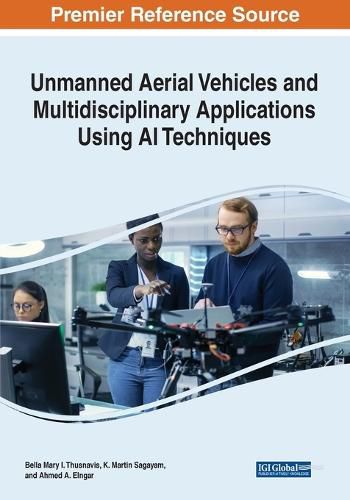Readings Newsletter
Become a Readings Member to make your shopping experience even easier.
Sign in or sign up for free!
You’re not far away from qualifying for FREE standard shipping within Australia
You’ve qualified for FREE standard shipping within Australia
The cart is loading…






This title is printed to order. This book may have been self-published. If so, we cannot guarantee the quality of the content. In the main most books will have gone through the editing process however some may not. We therefore suggest that you be aware of this before ordering this book. If in doubt check either the author or publisher’s details as we are unable to accept any returns unless they are faulty. Please contact us if you have any questions.
Unmanned aerial vehicles (UAVs) and artificial intelligence (AI) are gaining the attention of academic and industrial researchers due to the freedoms that UAVs afford when operating and monitoring activities remotely. Applying machine learning and deep learning techniques can result in fast and reliable outputs and have helped in real-time monitoring, data collection and processing, and prediction. UAVs utilizing these techniques can become instrumental tools for computer/wireless networks, smart cities, military applications, agricultural sectors, and mining.
Unmanned Aerial Vehicles and Multidisciplinary Applications Using AI Techniques is an essential reference source that covers pattern recognition, machine and deep learning-based methods, and other AI techniques and the impact they have when applied to different real-time applications of UAVs. It synthesizes the scope and importance of machine learning and deep learning models in enhancing UAV capabilities, solutions to problems, and numerous application areas. Covering topics such as vehicular surveillance systems, yield prediction, and human activity recognition, this premier reference source is a comprehensive resource for computer scientists; AI engineers; data scientists; agriculturalists; government officials; military leaders; business managers and leaders; students and faculty of higher education; academic libraries; academicians; and researchers in computer science, computer vision, pattern recognition, imaging, and engineering.
$9.00 standard shipping within Australia
FREE standard shipping within Australia for orders over $100.00
Express & International shipping calculated at checkout
This title is printed to order. This book may have been self-published. If so, we cannot guarantee the quality of the content. In the main most books will have gone through the editing process however some may not. We therefore suggest that you be aware of this before ordering this book. If in doubt check either the author or publisher’s details as we are unable to accept any returns unless they are faulty. Please contact us if you have any questions.
Unmanned aerial vehicles (UAVs) and artificial intelligence (AI) are gaining the attention of academic and industrial researchers due to the freedoms that UAVs afford when operating and monitoring activities remotely. Applying machine learning and deep learning techniques can result in fast and reliable outputs and have helped in real-time monitoring, data collection and processing, and prediction. UAVs utilizing these techniques can become instrumental tools for computer/wireless networks, smart cities, military applications, agricultural sectors, and mining.
Unmanned Aerial Vehicles and Multidisciplinary Applications Using AI Techniques is an essential reference source that covers pattern recognition, machine and deep learning-based methods, and other AI techniques and the impact they have when applied to different real-time applications of UAVs. It synthesizes the scope and importance of machine learning and deep learning models in enhancing UAV capabilities, solutions to problems, and numerous application areas. Covering topics such as vehicular surveillance systems, yield prediction, and human activity recognition, this premier reference source is a comprehensive resource for computer scientists; AI engineers; data scientists; agriculturalists; government officials; military leaders; business managers and leaders; students and faculty of higher education; academic libraries; academicians; and researchers in computer science, computer vision, pattern recognition, imaging, and engineering.